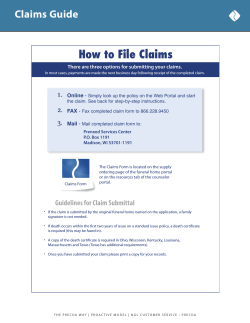
Elbow Arthroscopy - Basic Technique Portals and Anatomy
Lake Taho Knee and Shoulder Update 2002 Elbow Arthroscopy: Basic Technique, Portals and Anatomy Jeffrey Halbrecht MD Elbow Arthroscopy Experience Uncommonly scoped joint Based on AAOS Survey: •Only 7.6% of Orthopaedic Surgeons perform elbow arthroscopy •Elbow arthroscopy constitutes only 2% of all orthopedic procedures Elbow Arthroscopy The most hazardous joint in terms of risk to intimately associated neurovascular structures Poses greater technical challenges/neurologic risks than knee/shoulder scope Indications •Removal of Loose body(ies) •Olecranon Impingement Overload •OCD Capitellum •Debridement Degenerative Arthritis •Synovectomy •Diagnostic Evaluation •Capsular Release •Fx evaluation/Tx •Debridement Lateral Epicondylitis Positioning Supine Positioning Prone Positioning Lateral Decubitus Portals Anatomy Familiarity more critical than w/ any other arthroscopic procedure • Anterior • Posterior Anterior Portals • Assoc w/ greatest potential risk to nv structures • Thorough exam of anterior compartment important in all cases • Lateral • Medial Lateral Portals Anterolateral Portal Initially described by Andrews and Carson (Arthroscopy, 1:97-107, 1985) •3cm distal and 1-2cm anterior to lateral epicondyle •Penetrates Extensor Carpi Radialis Muscle Anterolateral Portal Visualization •Trochlea •Distal Humerus •Coronoid Process and Fossa •Medial and Superior Capsule Anterolateral Portal Structures @ Risk •LABCN ave. 7.6mm (0-20mm), in contact 43% •Radial nerve is “at extreme risk” ave. 4.9mm (2-10mm) –Recommended placement 3cm from LE results in entry point that is distal I most pts, below jt in some pts •PIN (fixed @ Arcade of Froshe) poorly protected, even in flexion, close to distal capsular attachment (little chance of displacement w/ jt distension) •No longer used by some, if used, established from “inside-out”, proximal to radial head Proximal Lateral Portal Described by Strothers, Day and Regan (Arthroscopy, Vol. 11, No4, 449449-457, Aug 1995) •1-2cm proximal to the lateral epicondyle, pierces Brachioradialis and distal Brachialis to reach lateral elbow capsule, lying directly on anterior surface of the humerus •Improved margin of safety, supplants earlier AL portal Proximal Lateral Portal Visualization •Anterior/Lateral aspect of Radial head and capitellum •Medial aspect of elbow including: •Coronoid Process/Fossa •Distal Humerus •Trochlea •Medial Capsule 0449F09_.95 Proximal Lateral Portal Structures @ Risk •LABCN branch ave 6.1mm (014mm), in contact 29% •Radial nerve 2x distance vs AL portal (ave 9.9mm in flexion) Medial Portals Anteromedial Portal •2cm distal, 2cm ant to medial epicondyle •Passes through common flexor origin, then beneath or penetrates brachialis to enter capsule Anteromedial Portal Visualization Affords excellent view of both radiocapitellar and ulnohumeral joints, coronoid fossa, capitellum and superior capsule Radial Head Capitellum Coronoid Process Trochlea Anteromedial Portal Structures @ Risk •MABCN Branch ave 1mm (0-5mm), in contact 71% •Median Nerve ave 7mm (5-13mm) w/ flexion •Brachial Artery ave 15mm (820mm) Proximal Medial Portal Described by Poehling (Arthroscopy, 5:222-224, 1989) •2cm proximal to medial epicondyle, directly anterior to intermuscular septum •Contact maintained w/ distal humerus to avoid med nerve risk •scope lies deep to brachialis muscle Proximal Medial Portal Visualization •Similar to AM portal •Excellent view, esp distal part of jt •Radiocapitellar jt •Ulnohumeral jt •70 Deg scope proximal capsule visualization prn Proximal Medial Portal Structures @ Risk •MABCN very close, ave. 2.3mm (0-9mm), in contact 56% •Median Nerve ave. 12.4mm (7-20mm) •Brachial Artery ave. 18mm •Ulnar Nerve av4e 12mm (718mm) Important to confirm location, stability of Ulnar nerve before establishing any medial portals Proximal Medial Portal Recommended that proximal medial portal be first portal used in most cases of elbow arthroscopy •Safer than anteromedial portal •Excellent view PM AM Posterior Portals All are relatively safe w/ distance to closest cutaneous or major nerve 1520mm –Mid or Direct Lateral (“Soft spot”) –Central Posterior –Posterolateral Mid-Lateral Portal AKA “Soft spot” portal •Located within triangle formed by olecranon, lateral epicondyle and radial head •Pierces Anconeus muscle •Initial joint insufflation •Only portal to provide easy access to posterior capitellum and radioulnar joint Mid-Lateral Portal Visualization •Posterolateral radial head •Capitellum •Trochlea notch •Olecranon Mid-Lateral Portal Structures @ Risk Articular Cartilage Central Posterior Portal •3cm proximal to Olecranon tip •Passes through triceps tendon at its medial margin Central Posterior Portal Visualization •Olecranon Tip •Olecranon Fossa •Posteromedi al Gutter Olecranon Tip Olecranon Fossa Central Posterior Portal Structures @ Risk Ulnar Nerve ave 19.1mm (15-25mm) Posterolateral Portal 3 cm proximal to olecranon tip, adjacent to lateral edge of triceps tendon Passes through triceps muscle Posterolateral Portal Visualization •Olecranon Fossa, Tip •Posterior trochlea Posterolateral Portal Structures @ Risk PABCN branch Technique - Video Complications • Relatively higher incidence compared to other scope procedures (3-14%) • Most significant is nerve injury (0-14%) • Radial/PIN most common (Median/Ulnar/AIN/MABC) (Rodeo etal JBJS A 1993;75:917-26) • • • • • Other reported complications include: Compartment syndrome Septic Arthritis Superficial infection Persistent Drainage Complications Complications 473 cases 11.8% complication rate 0.8% (N=4) “serious” – Infection 11% (N=50) “minor” •Prolonged drainage/superficial infection @ portal site (N=33) •Persistent minor contracture <20 deg (N=7) •Transient nerve palsies (N=12) (extravasation of local anesthetic, direct blunt trauma, compression by tourniquet/forearm wrapping, use of indwelling catheter) Avoiding Complications • Most serious complications are reported assoc. w/ advanced procedures, which ought to be performed only by experienced surgeons • Most minor complications however, are probably avoidable by – Familiarity w/ normal anatomy/portals – Attention to technique: • • • • • Incise skin only w/ #11 blade Blunt dissection to/through capsule Maintain portal sites (avoid repeated re-entry) Beware use of pump Limit procedure duration THANK YOU
© Copyright 2024









